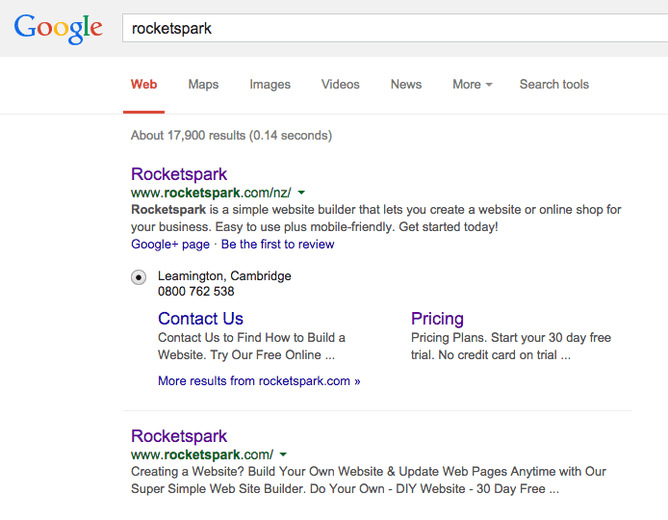So you’ve got a website—great—but how do people get there?
Digital marketers Conductor recently found that, if your website is like most, close to 64% of your website visitors get there via “organic” search engine results (as opposed to paid search results). So while some people will get there by clicking on a link and others will get there by typing your web address directly into their web browser, the majority come via Google and similar sites.
No surprise then that an entire industry exists that’s geared towards making your website appear as high up the search engine rankings as possible. It’s called search engine optimisation (SEO) and Top5SEO calls link building “the cornerstone of SEO”. It’s a powerful way to get more visitors to your site.
But there’s a problem. Link building know-how is often encoded in specialised techno-mumbo jumbo that’s liable to dissuade all but the most determined. In this three-part blog series we’re going to take a look a link building without the jargon, demystifying it and making it something that you can get started on yourself. Here’s an overview of each post:
Part 1: What is a link, and what is link building? We’ll answer those questions and how link building has changed over the past few years, as well as what makes a good quality backlink.
Part 2: What is the most important part of link building? We’ll address that question and delve into link building strategies, including how to “naturally” get links that’ll improve your rankings.
Part 3: What can I do to take more control over my link building? We’ll explore how to go beyond simply creating link-worthy content and how to create backlinks yourself. We’ll also list some excellent resources for further reading.
Links: voting with clicks
Link building is, in a nutshell, getting links from other sites that point to your own site, as a way of improving your rankings in search engines.
Unless you’ve been hiding under a proverbial rock, you already know what a link is. It’s this thing right here in highlighted text. But, hey, we’re “dummies”, so let’s just make sure we’re clear: a link is something you can click on—say, a snippet of text or an image—that will take you somewhere else, usually another webpage. In text, links usually appear in a different font colour and may also be underlined. And a link to your site, as opposed to from your site, is termed a backlink. Backlinks are handy for two reasons:
They’re signposts (directing web traffic). Backlinks are like signposts on a motorway, steering would-be passersby towards your place. If a link piques a reader’s interest, she’ll click on the link and take a looksie at your site. Might seem like an ah-duh! thing to say, since most of us have spent countless hours click-click-clicking during many a link bender. But it’s worth stating the obvious because frenzied link-builders often lose sight of this simple fact: regardless of SEO value, backlinks can help generate more traffic to your site by signposting visitors there.
2. They’re votes (improving search engine rankings). Backlinks are also like votes. Any time another site links to yours, essentially they’re voting for your content. It’s an implicit endorsement. So the more (quality) backlinks your site gets, the higher up your site will appear in relevant search queries in search engines like Google, Bing, Yahoo! etc. (for the purposes of these blog posts, I’ll just refer to Google, since it’s the most popular search engine by far. But most of what applies to Google here holds true for the other search engines as well). And ranking high up the search results is important; 33% of searchers click on the first result and 75% don’t look past the first page (i.e., first ten results). But note that I said these backlinks need to be quality; not all backlinks are created equal. For example, a backlink from a popular, highly authoritative site is great; a link from a shady “link farm”...not so much—in fact, it may actually be detrimental.
Link building centres on the second point. Like building an election-year political campaign, it’s all about securing votes (but, again, let me stress that quality matters, not just quantity). If you can do that, then you have a better chance of seeing your site near the top of Google’s search results. So this link to Wikipedia should, in theory, help Wikipedia’s search rankings (though it’s probably safe to say that the world’s sixth most popular website doesn’t really need a backlink from lil ol’ Rocketspark).
Link building then is simply increasing the number and/or quality of your backlinks so that you rank higher in Google so that, in turn, more people come to your website. Simple.
A brief history of link building: pandas, penguins and the little search engine that could
Link building has changed at breakneck speed over the past few years. It pays to know a little bit about the history of link building so you can make sense of the tangle of information that’s out there.
Before Google conquered the internet, search engines had comparatively basic methods of returning results to the user. Generally it was based on textual analysis of a site (AltaVista) or categorised by actual people (Yahoo!). What made Google so revolutionary when it burst onto the cyber-scene in the late 90s—and why it became so wildly popular—is that it consistently returned more relevant search results than the other engines (it’s clean, breath-of-fresh-air homepage probably didn’t hurt either). How? Links. Google was the first to treat backlinks as “votes”, analysing and using them as indicators of relevance.
So scoring backlinks became the name of the game. And game is the operative word here, because a lot of link building eventually came to be about gaming the system. SEO experts figured out how to artificially manipulate the rankings through obtaining links in ways that weren’t looked upon too kindly by Google (this kind of maverick approach is known in SEO circles as black hat). For example, websites would deviously slap a bunch of off-topic text on a webpage in the same color as the background, making it invisible to the eye but appearing to search engines as relevant to a topic that, in fact, it had nothing to do with. And that’s just the tip of the iceberg; there were plenty of similar fancy-schmancy but dubious techniques designed to dupe the search engines. The result? Relatively low-quality websites were sometimes able to rank disproportionately highly in search results.
Then, starting in 2011 (perhaps even earlier), came a series of updates to Google’s algorithm that spelled the end of the link building Wild West. Despite having cutesy names like Panda and Penguin, these updates were veritable H-bombs on the rankings of websites with an over-reliance on marginal link building techniques. Even internet colossuses like eBay were hit hard. This is all quite deliberate on Google’s part, of course. They’re engineering Google to become evermore sophisticated in ensuring that the best, most relevant sites appear high up in the search results. Or, in the pithy words of Eric Ward of Search Engine Watch, “it's gotten harder to get crappy content to rank high.” Great news for all us Google users; terrifying news for black hat link builders.
Okay, so nice history lesson and all—but what does it mean for link building right now? Put simply, nowadays the best and safest way to build links is to create quality content—webpages that people will want to link to. Link building 2014 is all about creating a great site—it’s what Google wants you to focus on and by abiding by their wishes, you future-proof your website from any upcoming algorithm updates that might otherwise knock your website down a peg (or fifty) in the search results.
The Strongest Link
But, that being said, link building still matters. Without links, your site is unlikely to show up prominently in Google. And where the “vote” metaphor for links breaks down is that, unlike the ideal democracy, not every vote has equal weight. As we’ve already noted, some links are better than others so, when it comes to backlinks, it’s not only quantity that matters but also quality.
What makes a quality backlink?:
- Popularity: The more popular a site, the more powerful a backlink from them will be.
- Authority: A link from a website perceived as having a high degree of authority (e.g. a large news website like the BBC) is superior to a site with low authority.
- Degrees of separation: The greater number of degrees of separation your site is from a popular or trusted site, the less powerful those links will be. For example, if www.bbc.co.uk links to you, that’s a big deal for your rankings. If BBC links to someone else and they link to you, that proximity to the BBC site isn’t quite as effective. And if the BBC links to someone who links to someone else who then links to you, it’ll be less effective again.
- Unique domains: Getting a backlink from a website (i.e., domain) that has never linked to you before has more weight than a backlink from a domain that has previously linked to you. Links from a diverse range of websites is better than a ton of links from just one or two sites.
- Anchor text: Anchor text is the word/phrase used for the actual link (e.g., this is anchor text). If a lot of your backlinks include a particular phrase, your site has a better chance of ranking highly in Google whenever that phrase is searched (Achtung! If a site has too many keyword-heavy anchor text links pointing to it, suggesting artificial manipulation of anchor text, Google tends to penalise that site’s rankings. Some research suggests that 60% seems to be the magic number of keyword/keyphrase anchor text that you don’t want to exceed.)
- Currentness: Old links tend to “decay” over time, so recent links usually have more value than aged links.
- Contextuality: Backlinking in the main body of text on a page (contextual backlinks) confer more value than text on other parts of the page, like the footer or sidebar.
- External vs. internal: Links from one page to another page on the same website have some value, but not as much as a backlink from another website.
- Topic similarity: A backlink from website that’s in a related field to yours will pack more punch than a site in an unrelated field.
- Proximity to spam: Links both from and to spammy websites can hurt your rankings (cf. the aforementioned “link farm” above).
Obviously, most backlinks will fall short of being absolutely perfect, but the more of these boxes it ticks, the more oomph it’s likely to pass onto your website in Google’s rankings.
Now that we’ve laid a foundation, it’s time to start discussing link building strategies. In Part 2 of this blog series we’ll explore “natural” link building: creating a website that’s a magnet for backlinks.



